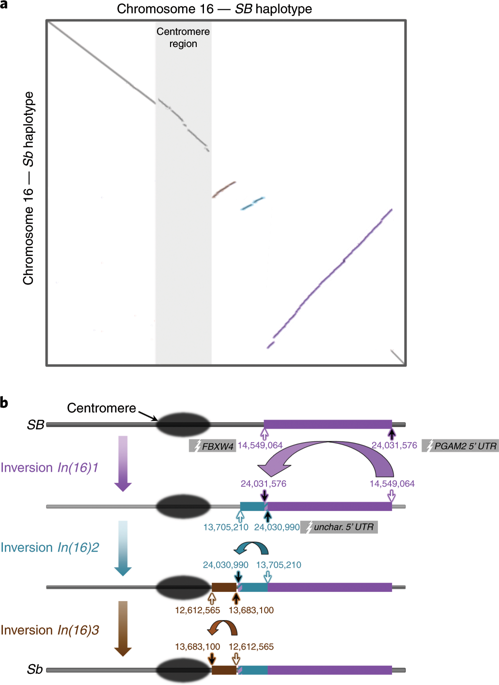Nature Ecology & Evolution ( IF 13.9 ) Pub Date : 2020-01-20 , DOI: 10.1038/s41559-019-1081-1 Zheng Yan 1 , Simon H Martin 2 , Dietrich Gotzek 3 , Samuel V Arsenault 4 , Pablo Duchen 5 , Quentin Helleu 1 , Oksana Riba-Grognuz 1 , Brendan G Hunt 4 , Nicolas Salamin 5 , DeWayne Shoemaker 6 , Kenneth G Ross 4 , Laurent Keller 1

|
Supergenes are clusters of linked genetic loci that jointly affect the expression of complex phenotypes, such as social organization. Little is known about the origin and evolution of these intriguing genomic elements. Here we analyse whole-genome sequences of males from native populations of six fire ant species and show that variation in social organization is under the control of a novel supergene haplotype (termed Sb), which evolved by sequential incorporation of three inversions spanning half of a ‘social chromosome’. Two of the inversions interrupt protein-coding genes, resulting in the increased expression of one gene and modest truncation in the primary protein structure of another. All six socially polymorphic species studied harbour the same three inversions, with the single origin of the supergene in their common ancestor inferred by phylogenomic analyses to have occurred half a million years ago. The persistence of Sb along with the ancestral SB haplotype through multiple speciation events provides a striking example of a functionally important trans-species social polymorphism presumably maintained by balancing selection. We found that while recombination between the Sb and SB haplotypes is severely restricted in all species, a low level of gene flux between the haplotypes has occurred following the appearance of the inversions, potentially mitigating the evolutionary degeneration expected at genomic regions that cannot freely recombine. These results provide a detailed picture of the structural genomic innovations involved in the formation of a supergene controlling a complex social phenotype.
中文翻译:

调节跨物种社会多态性的超基因的进化
超基因是连锁基因位点的簇,它们共同影响复杂表型的表达,例如社会组织。人们对这些有趣的基因组元素的起源和进化知之甚少。在这里,我们分析了来自六种火蚁本地种群的雄性全基因组序列,并表明社会组织的变异受一种新的超基因单倍型(称为Sb),它是通过连续合并跨越“社会染色体”一半的三个倒位而进化的。其中两个倒位中断了蛋白质编码基因,导致一个基因的表达增加,另一个基因的初级蛋白质结构适度截断。所研究的所有六种社会多态性物种都具有相同的三个倒位,通过系统基因组分析推断,它们共同祖先中超基因的单一起源发生在 50 万年前。通过多种物种形成事件, Sb与祖先SB单倍型的持续存在提供了一个功能上重要的跨物种社会多态性的显着例子,可能通过平衡选择来维持。我们发现,虽然Sb之间的重组和SB单倍型在所有物种中都受到严格限制,在出现倒位后,单倍型之间的基因通量水平较低,这可能会减轻无法自由重组的基因组区域预期的进化退化。这些结果提供了控制复杂社会表型的超基因形成所涉及的结构基因组创新的详细图片。











































 京公网安备 11010802027423号
京公网安备 11010802027423号